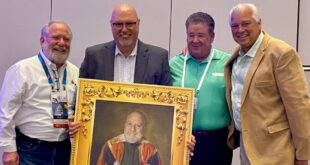In The Rime of the Ancient Mariner, there is a line that reads, “Water, water everywhere, and all the boards did shrink; water, water everywhere, nor any drop to drink.” If we were to write an epic poem about fighting fires in high-rise buildings, we might change the rhyme to read, “Water, water somewhere, and we need it very near; water, water somewhere, and we hold it very dear.”
What we are talking about of course is the need to utilize standpipes to take water from the ground level to the level in the building where the fire fight is occurring. This requires familiarity with NFPA 14, Standard for the Installation of Standpipes and Hose Systems, which is the theme of this month’s Sprinkler Age magazine.
NFPA 14 covers all of the systems, components and hardware, including the piping, fittings, valves, and pressure regulation devices, as well as system requirements, installation requirements, design plans and calculations, water supply, and system acceptance. The current edition of NFPA 14 has been revised and will be covered in other articles in this same issue. My focus is on the operational side of this as to why it is important to engage fire suppression personnel in maintaining and properly using standpipe systems under fire ground conditions.
Standpipes are required by the code in recognition of one phenomenon. In order to combat fire effectively, you have to have adequate fire flow on the fire floor within a reasonable timeframe. Standpipes placed in the building are intended to reduce the amount of time it takes to achieve that objective. When they are improperly designed or not properly maintained, they can affect the efficiency of the firefighters on scene. Standpipes can never be taken for granted. Regardless of the age of a building, standpipes must function as if they are brand new whenever a fire occurs.
During the initial construction phase of a building, standpipe installation can be compromised. It is very important that construction techniques support the activation of a standpipe as it moves up with the construction of the building. If a building is 20 stories high and a fire occurs during construction, fire flow is going to be as much in demand as if the building were complete, so coordination of standpipe installation is a serious task for fire prevention bureaus.
But, as equally important, is that this activity be coordinated with operations to assure that water supply is moving within the building at a reasonable rate. This type of activity often involves coordination with the fire suppression division as to access and availability of fire flow when a building is under construction.
All too often the installation of standpipes is handled entirely by the fire prevention bureau with little contact with operations. This is a planning consideration that should be changed. While it is appropriate that a bureau enforce the code and make sure the system is installed in accordance with NFPA 14, it is equally important that operations be aware of the installation. Again, this is directly related to the actual use of the system in the event of an emergency. Before the building is signed off, it is a good management practice to have the fire suppression division look at all the components. This would include, but not be limited to, everything from the standpipe inlet and access to external water supply up to and including the valves of the outlets on all the floors.
Now would be the time to pull out a copy of NFPA 1620, Standard for Pre-Incident Planning. This is the standard that provides criteria for developing pre-incident plans. Many times, organizations cannot visit construction sites until after the certificate of occupancy has been granted. This may be a little short sighted. You should visit them when they are under construction to see the parts that get covered up. NFPA 1620 places a lot of emphasis on fire protection systems. Time spent developing a pre-plan may reap significant benefits if and when an emergency actually occurs.
What I am suggesting is that NFPA 14 and NFPA 1620 are like the right hand and left hand of competency. Practicing one without consideration of the other is counterproductive.
At the end of the ancient mariner’s poem, he declares that he is “a sadder and a wiser man, he rose the morrow morn.” To me this sounds like learning from experience. If you have any buildings that are due to have standpipes installed, investing in the proper installations by following NFPA 14 is important, but utilizing the techniques of NFPA 1620 could be just as critical.
 ABOUT THE AUTHOR: Ronny J. Coleman is currently the president of Fireforceone. He is a past president of the IAFC and CFAI. Over his lifetime, he has received numerous awards including the AFSA’s 1989 Henry S. Parmelee Award, the 2011 Mason Lankford Award from the Congressional Fire Services Institute, and the Tom Brennan Lifetime Achievement Award from Fire Engineering in 2014. He continues as a contributor to the fire service in many ways.
ABOUT THE AUTHOR: Ronny J. Coleman is currently the president of Fireforceone. He is a past president of the IAFC and CFAI. Over his lifetime, he has received numerous awards including the AFSA’s 1989 Henry S. Parmelee Award, the 2011 Mason Lankford Award from the Congressional Fire Services Institute, and the Tom Brennan Lifetime Achievement Award from Fire Engineering in 2014. He continues as a contributor to the fire service in many ways.
 Sprinkler Age A Publication of the American Fire Sprinkler Association
Sprinkler Age A Publication of the American Fire Sprinkler Association

